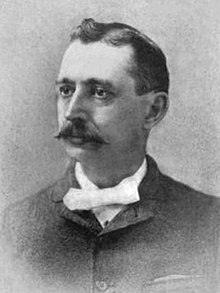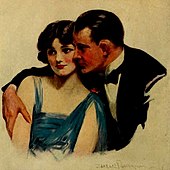| Company type | Private |
|---|---|
| Industry | Manufacturing |
| Founded | 1870 in Albany, NY |
| Founder | John H. Woodbury |
| Headquarters | Albany, NY |
| Products | Personal Care Products |
The Woodbury Soap Company was an American manufacturer of personal care products, such as cold cream, facial cream, facial powder, after-shave talc and ear swabs. Founded in Albany, New York, in 1870, it became a subsidiary of the Andrew Jergens Company in 1901. Woodbury soap continued as a brand into the 1950s, and was sponsor to popular radio programs in the 1930s and 1940s.
History

The John H. Woodbury company was established in 1870 in Albany, New York, by a dermatologist. The company was still in New York in 1901, making and retailing soap, when the Andrew Jergens Company (now a subsidiary of Kao) purchased the company which owned the soap brand, and moved the headquarters to Cincinnati, Ohio.
Between 1907 and 1910, the Andrew Jergens Co., John H. Woodbury and the John H. Woodbury Dermatological Institute were involved in lawsuits against one another for use of the name "Woodbury". In 1908 the John H. Woodbury Dermatological Institute was brought to court for practicing medicine without a license, and in 1911 they filed for bankruptcy protection. The litigation in the 1908 lawsuit, established precedent involving the state's right to prevent "corporations from practicing medicine." The defeated argument being that they did not need a license, as they were a corporation, not an individual.
The Institute was recapitalized and was purchased by Benjamin H. Freedman.
Ads and sponsorships


In 1911, the company became the first to use sex appeal to sell a product. Their ad slogan, created by the J. Walter Thompson Agency, claimed that women who used the soap would have "A Skin You Love To Touch". The slogan became so popular that Woodbury used it until the 1940s.
In 1936, Woodbury was one of the first companies to use nudity in its advertisements. The ad, known as "The Sun Bath", was photographed by Edward Steichen and showed a nude woman lying on stairs on her side with her back to the camera. The text advertised that Woodbury Soap was now enriched with "filter sunshine". Several celebrities also appeared in advertisements for Woodbury Soap. In 1938, debutante Brenda Frazier appeared in and for the company's soap which included a testimonial from the gossip columnist who was largely responsible for her fame, Cholly Knickerbocker). Future actress Oona O'Neill, who was then known as "New York's No. 1 "Deb", appeared in ads for the company's soap in 1943. In the 1940s and 1950s, actresses Lucille Ball, Virginia Bruce, Leslie Caron, Linda Darnell, Gloria DeHaven, Ava Gardner, Judy Garland, Veronica Lake, Myrna Loy, Marie McDonald, Merle Oberon, Donna Reed, Elizabeth Taylor (who also appeared in ads for the company's soap) Gene Tierney, and Esther Williams also appeared in ads for the company's cosmetics line.
The company also sponsored several radio shows. From 1933 to 1935, it was the sponsor of Bing Crosby's radio program Bing Crosby Entertains. In mid-1937, the company signed on to sponsor Bob Hope's radio show for 26 weeks. In 1936, they were a sponsor of the radio program Paul Whiteman's Musical Varieties on WJZ in New York City. From 1941 to 1942, the company sponsored The Adventures of the Thin Man, the 1940s radio show about husband-and-wife crime solvers that played the detective genre for laughs.
References
- "Facial Blemishes" (PNG). Retrieved 2023-09-25.
- "American Memory from the Library of Congress - List All Collections". loc.gov.
- "Kao Brands Company — Mission and Principles". Archived from the original on 2006-06-29. Retrieved 2006-07-29.
- Barry M. Horstman (1999-09-07). "Soapmaker built cosmetics giant". The Cincinnati Post. E. W. Scripps Company. Archived from the original on 2007-08-18.
- Corporation Plaintiffs 1824 to 1911, New York Chancery and Supreme Court Equity Action Ledgers. Renamed as New York Supreme Court Plaintiffs 1824–1911 online at www.ancestry.com
- Papers of Learned Hand 140-14
- Cross, Mary (2002). A Century of American Icons: 100 Products and Slogans from the 20th-Century Consumer Culture. Greenwood Press. pp. 40–41. ISBN 978-0313314810. Retrieved 4 September 2020.
- Sherrow, Victoria (2001). For Appearance' Sake: The Historical Encyclopedia of Good Looks, Beauty, and Grooming. Greenwood Publishing Group. p. 5. ISBN 1-573-56204-1.
- Diliberto, Gioia (1987). Debutante: The Story of Brenda Frazier (1 ed.). Alfred A. Knopf. p. 112. ISBN 0-394-53516-2.
- "Be a Beauty To your Soldier Boy! Here's How Deb Does It!". Life. Vol. 14, no. 10. Time Inc. March 8, 1943. p. 87. ISSN 0024-3019.
- Sterling, Christopher H.; O'Dell, Cary; Keith, Michael C., eds. (2011). The Biographical Encyclopedia of American Radio. Routledge. p. 82. ISBN 978-0-415-99549-8.
- Quirk, Lawrence J. (2000). Bob Hope: The Road Well Traveled. Hal Leonard Corporation. p. 94. ISBN 1-557-83450-4.
- Ewen, David (1977). All the Years of American Popular Music. Prentice-Hall. p. 293. ISBN 0-130-22442-1.
- Dunning, John (1998). On the Air: The Encyclopedia of Old-Time Radio (Revised ed.). New York, NY: Oxford University Press. p. 15. ISBN 978-0-19-507678-3. Retrieved 2019-10-13.